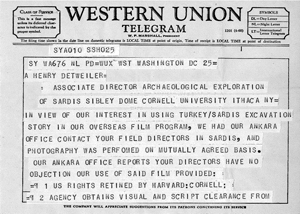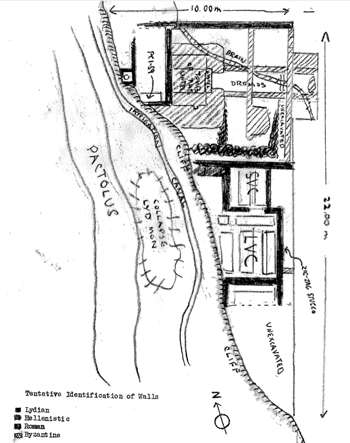
HENRY DETWEILER IN SARDIS: A LOOK INSIDE THE A. HENRY DETWEILER PAPERS
by Alyson Bowers, Archives Intern
Within the archive here at ASOR, there are many untapped collections full of stories that waiting to be uncovered by a researcher. The A. Henry Detweiler Papers is such a collection. The A. Henry Detweiler Papers contain the personal papers of former ASOR President Detweiler, whose tenure lasted from 1955 to 1966 – a fascinating time in our organizations history. After receiving his Bachelor of Architecture from the University of Pennsylavania in 1930, he participated in excavations and collaborations with archeology teams from Yale and Michigan State. Later, he taught architecture at Cornell University and served as the dean of the Architecture School there in 1956. His involvement with ASOR began in 1949 when he was acting director of the School in Jerusalem, continued with his presidency of the organization from 1955 to 1966, and lasted until his resignation, when he was appointed a Life Trustee, 1967-1970.

While the A. Henry Detweiler Papers comprises 6 boxes, the documents pertaining to Sardis span 19 folders and contain correspondence, financials, reports, press-related materials, and excavation sketches.
This excavation received much attention from the press over the three years that Detweiler was in charge. Detweiler kept around 100 newspaper clippings about the noteworthy accomplishments of the excavation, with headlines reading: “Site of Ancient City Discovered in Turkey” from Newport Daily News, September 3, 1958, and “Inscription in Language of Croesus Dug from Ruins of Ancient Sardis”, Post and Times Herald, July 23, 1958, to “Archaeologists Find Inscription to Lucius Verus” from Burlington Free Press, July 30, 1958.
Dr. Detweiler also kept news reports from Harvard University News Office itself, as they documented some of the excavation’s greatest findings through the years. Some of the most noteworthy early discoveries are the findings of inscriptions in the Lydian tongue, inscriptions in honor of Roman Emperor Lucius Verus, and the discovery of the exact location of Sardis. There are also later discoveries – like in August 1960, the discovery of the fortifications built by successors of Alexander the Great on the citadel of Sardis. In addition, the news reports from October 1960 chronicle the “remains of buildings destroyed by ‘sons of Hercules’ around 1200 BC and other destroyed about 600 years later by the King of Persia.” A year later, in October 1961, the Harvard Univeristy News Office released its Sardis findings, saying, “A marble avenue where ancient shoppers thronged, A Roman bath with colorful mosacis, and the first glimpse of the fabled golden riches of the capitol of Croesus are among important discoveries made by a Harvard-Cornell expedition in its fourth summer at Sardis, Turkey.”

Further information about the excavations can be gleaned from the interior reports kept by those on the Sardis excavation team. And while there are not many photographs in the A. Henry Detweiler Papers pertaining to the Sardis expedition, there are interesting report sketches, (see left) which comes from the “Report on the Pactolus Excavations” by Mario A. Del Chiaro in August 1959:
All of these different documents combine to help give us, as researchers, a fuller understanding of what Sardis meant to Dr. Detweiler. The significant amount of administrative material contained in the collection is evidence of Detweiler’s sizeable responsibilities pertaining to the excavation. The amount of reports kept indicates the level of care taken by the excavation team in detailing their findings and documenting the excavation’s progress. Finally the sheer number of neatly collected and organized newspaper clippings and press-related documents document how much the excavation meant to Dr. Detweiler, and how much it meant to the world.
Questions about A. Henry Detweiler or the ASOR Archive? E-mail the archivist.